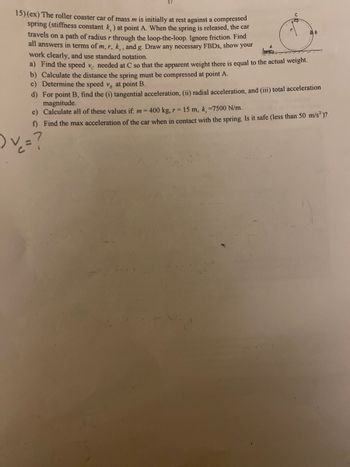Question
Parts a-c

Transcribed Image Text:15) (ex) The roller coaster car of mass m is initially at rest against a compressed
spring (stiffness constant k,) at point A. When the spring is released, the car
travels on a path of radius r through the loop-the-loop. Ignore friction. Find
all answers in terms of m, r, k,, and g. Draw any necessary FBDs, show your
work clearly, and use standard notation.
a) Find the speed ve needed at C so that the apparent weight there is equal to the actual weight.
b) Calculate the distance the spring must be compressed at point A.
с
c) Determine the speed v, at point B.
d) For point B, find the (i) tangential acceleration, (ii) radial acceleration, and (iii) total acceleration
magnitude.
e) Calculate all of these values if: m = 400 kg, r= 15 m, k, =7500 N/m.
f) Find the max acceleration of the car when in contact with the spring. Is it safe (less than 50 m/s²)?
) v = ?
Expert Solution
arrow_forward
Introduction:
The weight is balanced by centrifugal or centripetal force. This is condition where apparent weight is equal to actual weight. We then apply conservation of energy. The spring energy will become kinetic and potential energy at top. By this we can find velocity at top. We can also find velocity at point B.
Step by stepSolved in 4 steps
